There are no shortage of places to find tips on fly fishing in the fall. Most of those tips, including our 5 Tips for Fall Fly Fishing, focus on the latter half of the autumn season when sun angles have dipped, air and water temperatures have begun to take on a wintery feel and trout are fully into spawning mode. The beginning of the fall season, however, offers up excellent fishing opportunities at a time when most other anglers have hung up their waders for the season.
Just as early autumn weather conditions typically waver between summer-like and more traditionally autumn-like, so does trout trout behavior. As a result, a mix of summer and autumn fly fishing tactics can lead to greater success when on the water. Here are some thoughts to consider.
Go
This is first and foremost. As noted, many anglers reflexively stow their rods once the first week or two of September are crossed off the calendar. Don't. Go fishing. Pressure is dramatically reduced. Once busy waters become ghost towns. But only in regards to anglers, not fish.
Most importantly, the autumn months offer up fine fishing. In fact, you'll find no shortage of autumn-savvy anglers who will proclaim confidently that fall is their favorite time to fish. Many of those same anglers are also of the opinion that the abrupt and significant changes in angler pressure are a big part of why the fishing is so good when the trees start to shed their leaves.
Whatever the reason, autumn fly fishing is not to be missed.
Don't Forget the Dries
Another misconception is that autumn means strictly fishing nymphs and streamers, leaving little reason not to leave your dry fly boxes at home or in the truck. This isn't true at any point in the autumn, but most certainly isn't true in the early part of the season. Trout feed aggressively on dries well into autumn and some streams and rivers have abundant hatches of caddis, baetis, isonychia and more throughout September and October.
It's Still Terrestrial Time
When most anglers think of ants, beetles and grasshoppers, they think of the height of the summer season once temperatures have soared, drier conditions prevail and the mayfly hatches of the spring and early summer are well behind them. But, aggressive top-water feeding in early autumn isn't limited to caddis and mayflies. In fact, late September and early October can offer up some of the best terrestrial fishing of the year.
Summer Schedules Apply
As we wrote in our 5 Tips for Fall Fly Fishing, as fall works its way towards winter and water temperatures drop, early morning and late evening -- the time when most anglers expect to find feeding fish -- become less opportunistic times to ply the water, instead leaving the sun-warmed waters of midday an anglers best bet. In early autumn, however, summer schedules are still in effect on most waters. Though leaves have begun to turn and air temperatures have begun to chill, water temperatures have only changed marginally from the summertime conditions of just a few weeks before. Morning and evening remain the best time to target feeding trout through the first half of the autumn season, until water temperatures dip low enough (typically into the low 50s) to shift trout into more of a midday activity pattern.
Bugs Move, Leaves Don't
Anyone who has fished in the fall knows how blanketed the water can be with fallen leaves. These leaves serve as a perpetual annoyance both on and in the water, leading to lots of line retrievals to detach hooked leaves from your fly. These leaves can also make your dry fly fishing more difficult by making it harder for the fish to spot your fly. It's not that leaves look like flies, they don't, but leaves and other autumn debris on and in the water can add greatly to the visual confusion for an upward-looking trout.
One method of "helping" the fish to discern what might be food is breathing some life into your dry fly. Whether an olive, an iso or a beetle -- bugs can move, while leaves and debris cannot. Imparting some movement to your dry fly can help it appear more food-like to a trout and trigger a strike.





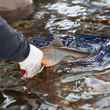
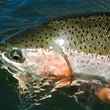




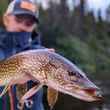
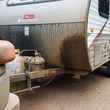




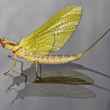




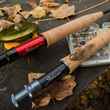







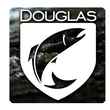
Comments
ginkthefly replied on Permalink
The first chilly week is my favorite terrestrial time. I have it in my head that trout get desperate that slim pickings are ahead once they detect a temperature drop and get more aggressive towards terrestrials. Anecdotal evidence at best, but my best days on land bugs (at least ants and beetles) always seem to come in September and October.
Rod replied on Permalink
What's up with the picture? Looks like the guy is having a cocktail and a cigarette, but no fly rod??
Daniel Carolan replied on Permalink
HAHA! Good observation.
Nate Hill replied on Permalink
As a guide who had been on the water every day so far this fall I can say that all of this is very accurate. My one comment would be that fish activity in general becomes more chaotic. For instance: on Monday there was a single hour of solid action from about 3:30 to 4:30 pm, Tuesday we had fish feeding all day long but somewhat sporadically, Wednesday fish were eating on the surface from about 11 am until 2:30 pm, thursday fish turned on just around 12:30 and were going strong until 4:30...then it shut down, today fishing was slow until about 4:30 then things turned on right until dark. So it isn't as sinplecas suggesting a time of day that is better in the fall. But a good rule of thumb is that you don't Need to get out early...just get on the water and stay out until the fish start feeding,,,,because they usually will..,at some point,
Pages